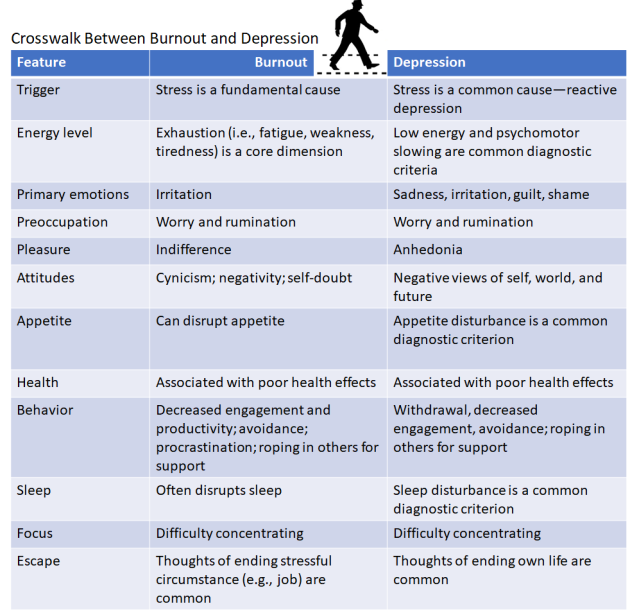Depression
Is This Depression or Burnout?
Stroll along this crosswalk to learn differences between depression and burnout.
Updated July 30, 2024 Reviewed by Margaret Foley
Key points
- Burnout and depression are often confused and difficult to tease apart.
- Relative to depression, burnout tends to be more specific to a situation or context, such as a work setting.
- Burnout may present with a different ratio of signs and symptoms (say, more cynicism) compared to depression.
What's the difference between depression and burnout? The two are often challenging to tease apart, and confusing them can get in the way of finding solutions. In other words, differentiating the two isn't just an academic performance; there are real-world consequences.
In this blog post, I'll define each concept before comparing them.
As an aside, I don't include any comments on burnout and depression in relation to perfectionism—the primary theme of this blog and my book, Flawed: Why Perfectionism Is a Challenge for Management.
Depression
Depression is a syndrome characterized by many distinct aspects. It’s dimensional in that you can have none or a ton of severity, with every degree in between.
When you have enough signs and symptoms of a depressive episode and they're severe enough, you’re diagnosable with something called major depressive disorder (MDD), a mental health condition. But very few presentations of MDD look the same.
What do I mean?
Fun fact—there are precisely 227 possible ways1 for an MDD episode to present in a person. For an episode, you need five or more depressive symptoms, but at least one of two primary features are required. Which two features? A depressive episode requires at least one of either (a) sad mood or (b) anhedonia (pronounced "anne-heh-dough-nee-uh").2
An-he-what?
Anhedonia means a lack of pleasure or interest. Somebody with depression may lose interest in or lack pleasure from activities (e.g., writing blogs [GASP!], video games, sex, reading, socializing) that they normally enjoy or have enjoyed in the past.
I find it fascinating that you can have a depressive disorder but have zero sadness. That is, you can present with anhedonia but not sadness. Does that blow your mind? Depression doesn't always mean sad.
By the way, in some people, especially children, sadness can look a lot like irritability, and the anhedonia can resemble profound boredom (i.e., ennui, which is a super fun word to say and therefore feels opposite of its meaning).
The other symptoms/signs that can qualify you for an MDD episode include sleep disturbance; appetite changes (often based on weight fluctuations); low energy; changes in body movements, which can take opposite forms, such as slow (i.e., psychomotor retardation) or jittery movements (i.e., psychomotor agitation); feeling guilty or worthless; worsened concentration; and increased suicidal thoughts or thoughts of death more generally.3
So, as you can see, MDD can present with various combinations of signs and symptoms. By the way, this is called polythetic diagnostic criteria. New Scrabble word!
In addition, for many people, MDD is episodic—that is, you have episodes of depression that last for at least two weeks and come and go over a lifetime (with at least one month in between episodes).4 Often MDD looks different from episode to episode, even for the same person.5
Then, what is burnout?
Burnout
Burnout is an unpleasant syndrome that occurs from stress. You tend to see burnout in high-pressure scenarios, such as work settings and caretaker roles. For example, it's not uncommon to see an election attorney become burnt out with their job during election season, when their stress level is skyrocketing. Similarly, burnout is a likely state for a 40-year-old single mother (of small children) who also happens to be caretaking for her father with advanced dementia. Society even has a cutesy/flippant name for this stressful life stage—the sandwich generation.
Burnout is characterized by different but connected dimensions: exhaustion; cynicism and disconnection; and decreased achievement.6 "Exhaustion" refers to the feeling of being emotionally and physically depleted. You're running on empty. "Cynicism" and "Disconnection" refer to the social and mission components of burnout. You stop caring about the purpose of your involvement. You develop negative attitudes and exhibit irritability. You feel compelled to avoid and escape activities related to your role. "Decreased achievement" is the behavioral results of burnout. You stop or slow down engaging in tasks, which reduces production.
These burnout characteristics feed into each other and are therefore related. For mental health experts, this may sound familiar....
Burnout and Cognitive Behavioral Therapy (CBT)
If you're a psychologist who specializes in cognitive behavioral therapy (CBT), you may see considerable overlap with the CBT triangle and conceptualization.

The CBT triangle depicts the interconnectedness of thoughts, feelings, and behaviors in a given situation. For example, in a stressful work situation, you might think that you'll never escape your new duties (i.e., thoughts), which then leads to feelings of frustration and guilt (i.e., feelings). This cascade may then result in withdrawing from your role and snapping at others (i.e., behaviors). The point of CBT is to shatter this cycle.
This discussion of CBT isn't a self-indulgent sidebar. The CBT triangle seems to parallel the different dimensions of burnout. It's not a perfect mapping, but it's pretty darn close.
First, burnout's "Exhaustion" maps on to CBT's "Feelings." Second, the "Cynicism" and "Disconnection" coincide with "Thoughts." Third and lastly, "Decreased achievement" parallels CBT's "Behavior."
Comparing Depression and Burnout: Similarities
Based on everything I've described, it's easy to see how burnout and depression can be confused. There are a lot of similarities.
In the figure below, I've created a crosswalk that shows similarities between burnout and depression. I make no claims about it being an exhaustive list, but it's a good place to start. (And for the record, I really wanted to use the Beatle's Abbey Road crosswalk cover for the figure but didn't want to deal with pesky rights issues.)

So, as you can see, there is considerable overlap between burnout and depression. Do they have any differences?
Comparing Depression and Burnout: Differences
Yes, depression can be the result of stressors—what we call reactive depression—but it can often occur in the absence of triggering stressors. When depression presents without commensurate situational stressors, we call this endogenous depression. This blog post predominantly focuses on reactive depression, as it's quite different from endogenous depression.7
In addition, although burnout can result from multiple simultaneous stressors—and it often negatively affects multiple areas of life at the same time (such as in the workplace or at home)—its presentation is usually narrower than depression. That is, unlike with depression, the personal distress from burnout is mostly focused on one or two specific areas of life. It doesn't always generalize to other areas. For example, you might experience burnout with your job or as a caretaker, but you may feel fine at home with your family (or vice versa).
Depression doesn't respect these types of situational boundaries—it feels terrible in most situations and places.
For this reason, with burnout, many of the negative attitude components, such as self-doubt and cynicism, may be restricted to a specific setting or situation. For depression, it's more global. It sticks its tentacles in everything.
Although burnout and depression share some unpleasant emotions (e.g., irritation, sadness, and so on), predominant presentations in each seem to vary. Burnout may have a higher ratio of irritability relative to the other emotions.
Concluding Thoughts
Burnout and depression have many similarities and some differences. All told, it seems like these constructs tap into the same underlying phenomenon, perhaps one that we just haven't defined very well (yet!). This would suggest that third variables (e.g., neuroticism) explain both.
Burnout also might be a narrow form of depression, a precursor to or cause of depression, the result of depression, or "Yes, all of the above." As with much of life and its causal dynamics, there's probably a feedback loop in which burnout and depression feed into each other. It's also worth noting that depression and burnout aren't mutually exclusive; you can have both simultaneously (fun times!).
I hope you feel more informed about burnout vs. depression. I'm burnt out on this blog post. Until next time...
References
1. Zimmerman M, Ellison W, Young D, Chelminski I, Dalrymple K. How many different ways do patients meet the diagnostic criteria for major depressive disorder? Compr Psychiatry. 2015 Jan;56:29-34. doi: 10.1016/j.comppsych.2014.09.007. Epub 2014 Sep 6. PMID: 25266848. ↩︎
2. American Psychiatric Association. Diagnostic and Statistical Manual of Mental Disorders. 5th ed., Text Revision, American Psychiatric Publishing, 2022, https://doi.org/10.1176/appi.books.9780890425787. ↩︎
3. Ibid. ↩︎
4. Ibid. ↩︎
5. Klein DN, Shankman SA, Rose S. Ten-year prospective follow-up study of the naturalistic course of dysthymic disorder and double depression. American Journal of Psychiatry. 2006;163(5):872–880. ↩︎
6. Edú-Valsania S, Laguía A, Moriano JA. Burnout: A Review of Theory and Measurement. Int J Environ Res Public Health. 2022 Feb 4;19(3):1780. doi: 10.3390/ijerph19031780. PMID: 35162802; PMCID: PMC8834764. ↩︎
7. Shorter E. The doctrine of the two depressions in historical perspective. Acta Psychiatr Scand Suppl. 2007;(433):5-13. doi: 10.1111/j.1600-0447.2007.00957.x. PMID: 17280565; PMCID: PMC3712975.; Malki K, Keers R, Tosto MG, Lourdusamy A, Carboni L, Domenici E, Uher R, McGuffin P, Schalkwyk LC. The endogenous and reactive depression subtypes revisited: integrative animal and human studies implicate multiple distinct molecular mechanisms underlying major depressive disorder. BMC Med. 2014 May 7;12:73. doi: 10.1186/1741-7015-12-73. PMID: 24886127; PMCID: PMC4046519. ↩︎




